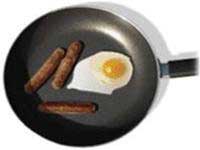Hazards from non-stick pans
 Using non-stick pots and pans with Teflon coating is convenient: there is no need to use a lot of fat, fried food is not stuck in the pan, keeping the beautiful shape of fish, meat pieces . But there are also insecurities from these modern kitchen products.
Using non-stick pots and pans with Teflon coating is convenient: there is no need to use a lot of fat, fried food is not stuck in the pan, keeping the beautiful shape of fish, meat pieces . But there are also insecurities from these modern kitchen products.
The pan does not stick . sticky
Non-stick pots and pans no matter how thoroughly used (do not wash with objects that can scratch the coating, do not use metal spoons, patches .) are also very fast. Only after a period of use, the coating began to deteriorate, indicating that they were peeling and perhaps the chips were very small so we could not see. Worse yet, they can be peeled in large pieces.
In both cases, the non-stick pan starts to stick. At that time, according to the manufacturer's suggestion, you should not regret it anymore but throw it away. So it is really wasteful and inconvenient. However, consumers still feel insecure and wonder: then where are the crumbs that we can't see if they come out if they are not mixed into food when cooking? And is it toxic to swallow them with food? This question is mostly answered when scientists around the world pose a risk from these non-stick cookware.
Risk from PFOA in Teflon
It was discovered that the perfluorooctanoic acid compound, PFOA, is one of the components in Teflon production, found in traces in blood samples tested throughout the United States, with a high content close to the amount harm in lab animals. Experiments showed that mice exposed to large amounts of PFOA generated tumors . A report by the US Environmental Protection Agency Advisory Council EPA made recommendations: 'PFOA is likely to be a substance. cause cancer in people ', and promote EPA to take adaptation measures.
Advice
- The above poisonous gas phenomena can cause harm to humans, for birds . when you use in a closed room like in cold countries. In the case of our country, the new kitchen is usually well ventilated, this risk may be less. If in case you feel anything unusual, turn off the stove, bring the pan to the outside, place them on a non-flammable plane so that the gas fills out. In the house, open the door for ventilation.
- Be careful with all Teflon-coated items, including coats, carpets . It is advisable not to use Teflon-coated heating lamps. Do not leave pots and pans unattended on the stove without watching, it may overheat produce toxins. When they are not too hot, they can be safe. When they are old, the surface of the coating feels no longer smooth, at that time it should not be cheap but throw them away.
Early EPA studies showed that PFOA causes cancer in mice, but it has not been identified in humans. The most vulnerable part of the chemical is the liver, and PFOA is also found in the milk of laboratory mice. Also last month, EPA brought Dupont to court for failing to meet EPA's requirement to provide information about PFOA.
Meanwhile, the Teflon manufacturer assured that there was no PFOA in the Teflon coating in the pan when cooking because PFOA was decomposed during production. At the same time, they also ensure that their tests show that PFOA is not dangerous.
Toxic gas from Teflon
While the debate about Teflon in PFOA is ongoing, more recently, there has been a claim of Teflon from bird breeders. Darrel K Styles of the Schubot Exotic Bird Health Center of Texas A&M University calls Teflon a silent killer.
Teflon or rather polytetrafluoroethlyene (PTFE) is a poisonous gas that kills any bird. This toxicity is caused by the gas emitted from the material that makes the nonstick agent for the pan. Teflon toxic gas also occurs when used in heating lamps, high temperatures make the Teflon coating heat up and evaporate. This gas is not toxic to humans and mammals but is extremely sensitive to birds and quickly poisoned.
Previously, Dupont said that this coating was heat-stable, did not produce toxic gas or chemicals. Now, in a press release, they said: Teflon coating was significantly decomposed when the temperature exceeded 6600F (3400C). At 4460F, Teflon emits granular toxin, at 6800F, Teflon pans emit at least 6 toxic gases, including 2 can cause cancer, 2 environmental pollutants and MFA are chemicals lethal in low doses. At a destruction temperature of 1.0000F, the anti-nutritive layer decomposes into a substance that is a chemical weapon PFIB and a chemical similar to phosgen neurotoxin.
- Using a non-stick pan may have cancer
- Non-stick pan causes aging in women
- Use a non-stick pan properly to protect your health
- Selfie stick was born 88 years ago?
- Gum does not stick and self-destruct
- How to use the wrong kitchen tool makes you face many dangerous diseases
- 7 unexpected danger in the family
- Pregnant women and chemicals
- Your tongue will stick to the cold metal
- Video: Why is Teflon so good at sticking?
- Anti-stick and development of children
- Non-stick gum
 Green tea cleans teeth better than mouthwash?
Green tea cleans teeth better than mouthwash? Death kiss: This is why you should not let anyone kiss your baby's lips
Death kiss: This is why you should not let anyone kiss your baby's lips What is salmonellosis?
What is salmonellosis? Caution should be exercised when using aloe vera through eating and drinking
Caution should be exercised when using aloe vera through eating and drinking